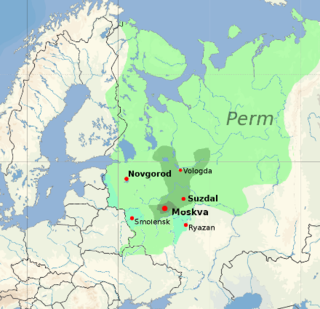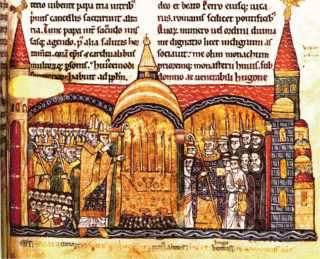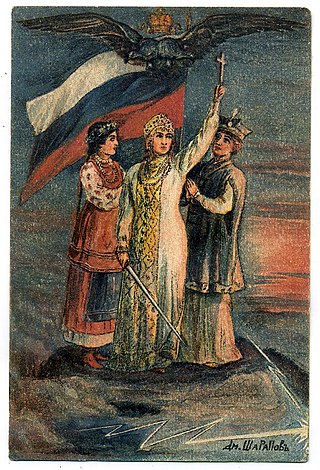
The Eastern Orthodox Church, officially the Orthodox Catholic Church, and also called the Greek Orthodox Church or simply the Orthodox Church, is the second-largest Christian church, with approximately 230 million baptised members. It operates as a communion of autocephalous churches, each governed by its bishops via local synods. The church has no central doctrinal or governmental authority analogous to the head of the Catholic Church. Nevertheless, the Ecumenical Patriarch of Constantinople is recognised by them as primus inter pares, a title formerly given to the patriarch of Rome. As one of the oldest surviving religious institutions in the world, the Eastern Orthodox Church has played an especially prominent role in the history and culture of Eastern and Southeastern Europe.

The Russian Orthodox Church, alternatively legally known as the Moscow Patriarchate, is an autocephalous Eastern Orthodox Christian church. It has 194 dioceses inside Russia. The primate of the ROC is the Patriarch of Moscow and all Rus'.

Vladimir I Sviatoslavich or Volodymyr I Sviatoslavych, given the epithet "the Great", was Prince of Novgorod from 970 and Grand Prince of Kiev from 978 until his death in 1015. The Eastern Orthodox Church canonised him as Saint Vladimir.

Slavic paganism, Slavic mythology, or Slavic religion is the religious beliefs, myths, and ritual practices of the Slavs before Christianisation, which occurred at various stages between the 8th and the 13th century.

The culture of Kievan Rus' spans the cultural developments in Kievan Rus' from the 9th to 13th century of the Middle Ages. The Kievan monarchy came under the sphere of influence of the Byzantine Empire, one of the most advanced cultures of the time, and adopted Christianity during the Christianization of Kievan Rus'. After the gradual fragmentation of the dynasty into many Rus' principalities in the 13th century, Kievan Rus' culture faded with the Mongol invasion of Kievan Rus' in the 13th century, and Batu Khan's establishment of the Golden Horde as the regional hegemon of Eastern Europe.

The Russian Orthodox Church is traditionally said to have been founded by Andrew the Apostle, who is thought to have visited Scythia and Greek colonies along the northern coast of the Black Sea. According to one of the legends, St. Andrew reached the future location of Kiev and foretold the foundation of a great Christian city. The spot where he reportedly erected a cross is now marked by St. Andrew's Cathedral.

Eastern Orthodox Christianity in Norway is a small minority religion in Norway with 11,205 official members in 2012, up from 2,315 in 2000. although the church is rapidly growing, and predicted to surpass other Christian denominations.
The Russian Orthodox Cross is a variation of the Christian cross since the 16th century in Russia, although it bears some similarity to a cross with a bottom crossbeam slanted the other way (upwards) found since the 6th century in the Byzantine Empire. The Russian Orthodox cross has three horizontal crossbeams, with the lowest one slanted downwards. Today it is a symbol of the Russian Orthodox Church and a distinctive feature of the cultural landscape of Russia. Other names for the symbol include the Russian cross, and Slavonic or Suppedaneum cross.

The Principality of Moscow or Grand Duchy of Moscow, also known simply as Muscovy, was a principality of the Late Middle Ages centered on Moscow. It eventually evolved into the Tsardom of Russia in the early modern period. The princes of Moscow were descendants of the first prince Daniel, referred to in modern historiography as the Daniilovichi, a branch of the Rurikids.
The word Rus' referred initially to a group of Scandinavian Vikings, also known as Varangians, who founded the medieval state of Kievan Rus' in Eastern Europe in the 10th century. The term gradually acquired the meaning of the aforementioned dynastic polity itself, and also the geographic region of its heartlands Kiev, Pereiaslavl' and Chernihiv. Russia is a Hellenized rendition of the same word, and Ruthenia is its Latinized form.

Kievan Rus', also known as Kyivan Rus', was the first East Slavic state and later an amalgam of principalities in Eastern Europe from the late 9th to the mid-13th century. Encompassing a variety of polities and peoples, including East Slavic, Norse, and Finnic, it was ruled by the Rurik dynasty, founded by the Varangian prince Rurik. The name was coined by Russian historians in the 19th century to describe the period when Kiev was at the center. At its greatest extent in the mid-11th century, Kievan Rus' stretched from the White Sea in the north to the Black Sea in the south and from the headwaters of the Vistula in the west to the Taman Peninsula in the east, uniting the East Slavic tribes.

In the 9th century, Christianity was spreading throughout Europe, being promoted especially in the Carolingian Empire, its eastern neighbours, Scandinavia, and northern Spain. In 800, Charlemagne was crowned as Holy Roman Emperor, which continued the Photian schism.

By the 10th century, Christianity had spread throughout much of Europe and Asia. The Church in England was becoming well established, with its scholarly monasteries, and the Roman Church and the Eastern Orthodox Church were continuing their separation, ultimately culminating in the Great Schism.

The term "Great Church" is used in the historiography of early Christianity to mean the period of about 180 to 313, between that of primitive Christianity and that of the legalization of the Christian religion in the Roman Empire, corresponding closely to what is called the Ante-Nicene Period. "It has rightly been called the period of the Great Church, in view of its numerical growth, its constitutional development and its intense theological activity."

The All-Russian nation or triune Russian nation, also called the pan-Russian nation, is the term for the Imperial Russian and later irredentist ideology that sees the Russian nation as comprising a "trinity" of sub-nations: Great Russia, Little Russia, and White Russia. Respectively, these sub-nations are contextually identified with Russians, Ukrainians, and Belarusians. Above all, the basis of the ideology's upholding of an inclusive Russian identity is centered around bringing all East Slavs under its fold.
The Metropolis of Kiev and all Rus' was a metropolis of the Eastern Orthodox Church that was erected on the territory of Kievan Rus'. It existed between 988 AD and 1440s AD. The long lasting "tug of war" between bishops from the Great Duchy of Lithuania and Ruthenia and bishops of the Great Duchy of Moscow resulted in reorganization of the metropolis as the bishops from Moscow refused to recognize decisions of the Ecumenical Patriarch of Constantinople. Canonically, it was under the jurisdiction of the Ecumenical Patriarchate of Constantinople. The metropolitan seat (cathedra) was located in the city of Kiev until it was moved to Vladimir-na-Klyazme in 1299 and then Moscow in 1325.
The schism between the Ecumenical Patriarchate and part ofitsMetropolis of Kiev and all Rus occurred between approximately 1467 and 1560. This schism de facto ended supposedly around 1560.

Moscow, third Rome is a theological and political concept asserting Moscow as the successor to ancient Rome, with the Russian world carrying forward the legacy of the Roman Empire. The term "third Rome" refers to a historical topic of debate in European culture: the question of the successor city to the "first Rome" and the "second Rome".
Topical outline of articles about Slavic history and culture. This outline is an overview of Slavic topics; for outlines related to specific Slavic groups and topics, see the links in the Other Slavic outlines section below.














